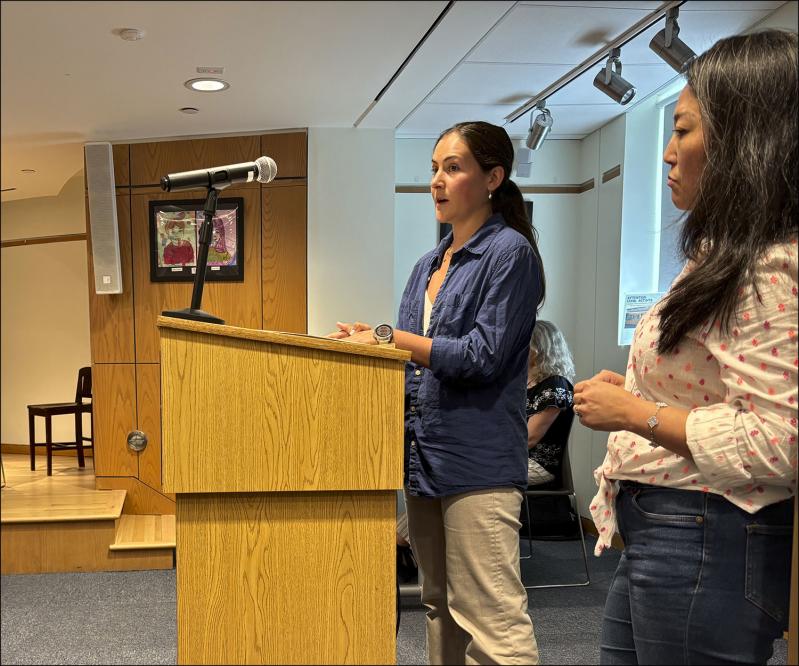Nearly 60 people crammed into the basement of the Montauk Library for the East Hampton Town Board meeting on Tuesday, at least two of them barefoot, ostensibly for a presentation by the Concerned Citizens of Montauk about a proposed water quality project at Fort Pond requiring the board’s permission.
The nonprofit also requested minimal help from the town, including nine hours of staff time from the Natural Resources Department and water protection district data for the Fort Pond watershed.
The board was fully supportive.
“Many residents have expressed to us what the pond used to be,” said Rebecca Holloway, C.C.O.M.’s manager of environmental advocacy. “It was once an important waterfowl wintering area in the 1970s and ‘80s. For the past decade, however, we’ve had a very different story in the pond. It’s now classified as a section 303(d) impaired water body by the state.”
Dubbed the “Save Montauk’s Waters” campaign, the plans she presented with Kay Tyler, the executive director of C.C.O.M., to help the beleaguered water body were equal parts education and action.
“The ultimate goal of this study is solid, evidence-backed recommendations for remediation of toxic blue-green algae and pathogenic bacteria in the pond, that will be cost effective and long lasting,” Ms. Holloway told the room.
To that end, C.C.O.M. has contracted Christopher Gobler of Stony Brook University’s School of Marine and Atmospheric Sciences to provide a 12-month comprehensive study of Fort Pond’s water quality.
He will provide a buoy that will transmit continual live results of the pond’s health. Using the results of that sampling, high resolution maps of contamination sources will be developed. He will provide an interim report and at the end of the study, recommend remediation solutions.
“We finally plan to get a deep understanding of what’s happening in Fort Pond,” Ms. Holloway said. “C.C.O.M. now records and reports frequent exceedences of state health standards in Fort Pond, but the sources remain largely unknown. This study will use genomic tools, called microbial source tracking, to pinpoint the sources of the bacteria.”
Another aspect of the campaign will be a focus on educating and helping residents in the Fort Pond watershed to upgrade their septic systems to new low-nitrogen varieties. Ms. Tyler said “Approximately 31 properties out of 343 have upgraded their septic or are in the process of doing so.”
“That’s not a lot, guys. Only about 10 percent of the properties in that watershed have made that change,” said Councilman Tom Flight. “Fort Pond is something those of us who live in Montauk, we see it every day. When you see those images of green water in there, it’s devastating.” Mr. Flight also called out a dilapidated fishing pier that extends into the pond from Kirk Park and has been closed for years.
“Its condition is unacceptable. It’s a way to encourage future generations to start caring about this water body.” He called for its restoration.
C.C.O.M. will assist residents with septic upgrade grant applications and hold a seminar on the process and another on an application “walk through.”
Further, on the education front, it hopes to sign up 150 “clean water stewards” who make a commitment to clean water by choosing from a list of 10 action items, such as picking up pet waste “even in your own yard,” planting native trees, flowers, and shrubs, and using “organic fertilizer or none at all.”
The group also requested permission to place signs near the pond, in English and Spanish, to educate people about its water quality issues.
While the focus was on septic systems, at least one resident, East Hampton Town Trustee Jim Grimes, wasn’t convinced that was the biggest issue. Deputy Supervisor Cate Rogers, running the meeting in the absence of Town Supervisor Kathee Burke-Gonzalez, allowed him to speak, even though there wasn’t a public comment period, out of respect for his trustee status.
A wastewater treatment facility for downtown Montauk would help more than replacing septic systems in the watershed, he said, while acknowledging that was also important.
“I’m happy to tell you that we have a grant and a working partnership now with Suffolk County for that same issue,” Ms. Rogers told him.
Meanwhile, he said, a past study identified that 85 percent of the pollution into the pond came from road runoff. “This problem needs some study, but what it really needs is action.”
He suggested using community preservation funds dedicated to water treatment projects to create a manufactured wetland at Kirk Park which he argued is “predominately invasive, non-native plants at this time.” A pipe that takes road runoff directly into the pond could be directed through the wetland.
“Create a beautiful wetland. Create an elevated handicapped accessible walkway through it to a scaled-down fishing pier,” he suggested.




